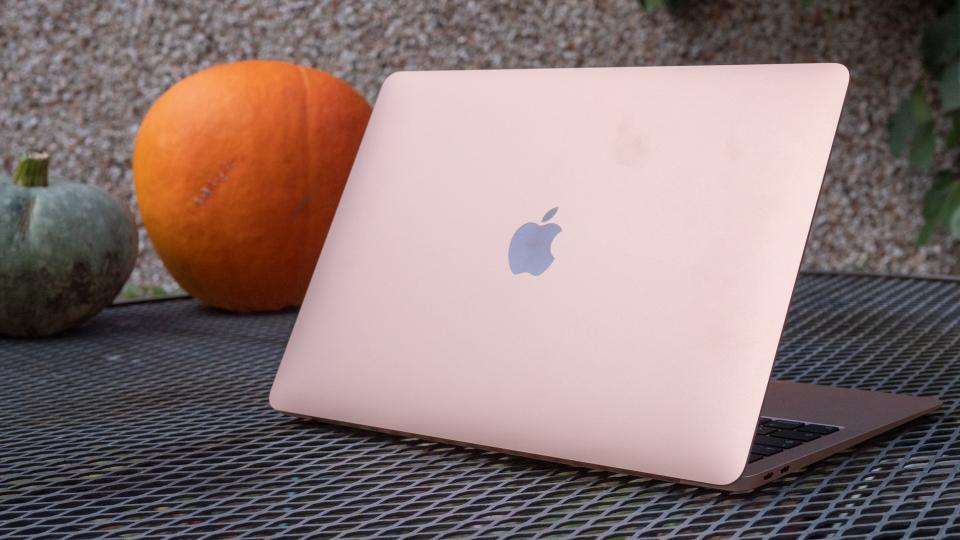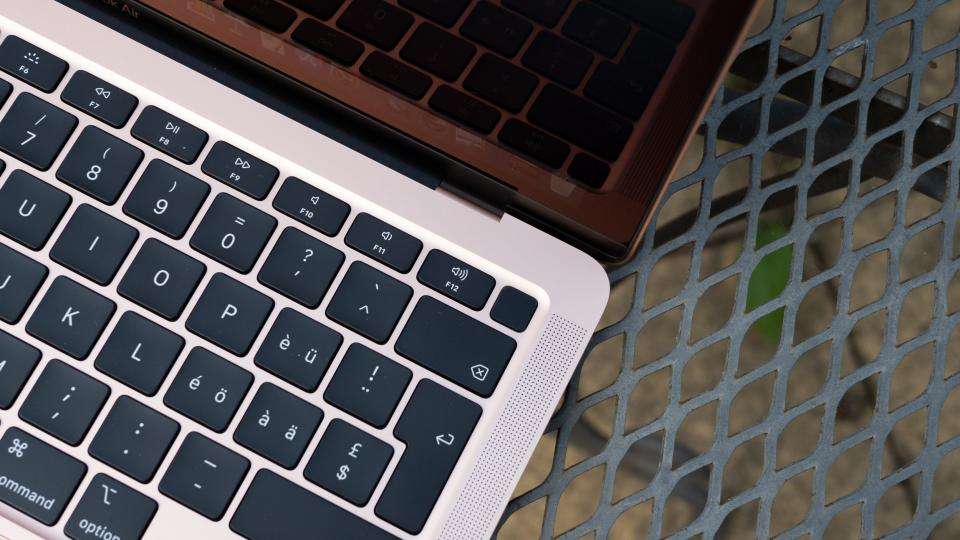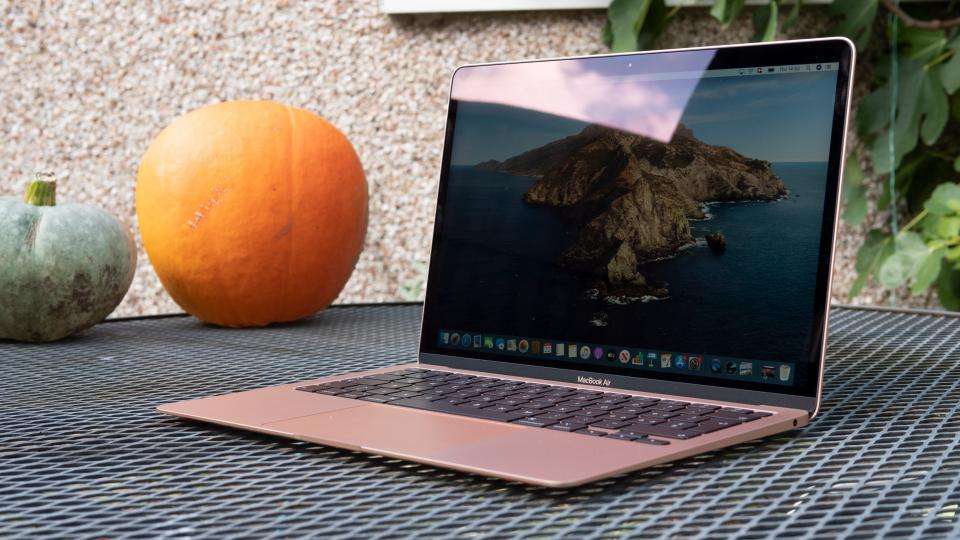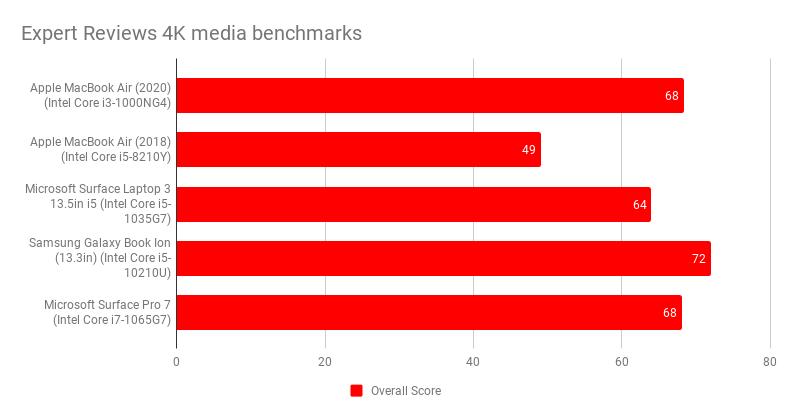Two years ago saw the return of the MacBook Air after years in the wilderness and it was a solid return to the mid-range for Apple, offering a more affordable option to cash-strapped MacBook-starved fans everywhere.
The 2020 MacBook Air takes that recipe and tweaks it slightly but, in typical Apple style, doesn’t do anything to undermine its appeal. Despite strong competition from the increasingly competent Windows fraternity, the Apple MacBook Air (2020) remains one of the best ultraportable laptops in its price bracket.
READ NEXT: These are the best laptops to buy today
Apple MacBook Air 2020 review: What you need to know
This year’s MacBook Air does have some new features. It has a new keyboard with more travel and damping to each key. The chassis is a tiny bit thicker and a few grams heavier, too; not that you’d notice in isolation because, in appearance, very little has changed.

There are, of course, new internals this year, with the MacBook Air moving to 10th-gen Intel chips across the range, but elsewhere everything is in stasis. Apple introduced its True Tone technology in 2019 to update the display and that remains in place here, but the rest of the package remains the same as the original reboot. This is a 13.3in ultraportable laptop with no touchscreen, and it’s all housed in an attractive aluminium clamshell chassis with that trademark MacBook Air wedge-shaped profile.
Apple MacBook Air 2020 review: Price and competition
Perhaps most significantly, at £999, the base model of the 2020 Apple MacBook Air is now £200 cheaper than the model it replaces. That cash scores you a machine with a 1.1GHz dual-core Intel Core i3, mind, so on paper it’s no great shakes in the performance department. This is backed by 8GB of RAM and a minimum 256GB of fast SSD storage.
You can go mad with the specification if you really want, with the quad-core 10th-gen Core i7 with 16GB of RAM and a 2TB SSD bumping up the price to £2,249. At that point, though, you probably want to be looking at a MacBook Pro instead. Indeed, it’s not that much of a leap from here to a MacBook Pro 16in , which comes with a more powerful 9th-gen, six-core Core i7 for £2,399 .
At the lower end of the MacBook Air’s price range, there’s plenty of competition in the thin and light laptop category. Examples include the Microsoft Surface Laptop 3 13.5in , which starts at £999, for a configuration that includes a Core i5 with 8GB of RAM and a 128GB SSD (half the size of the MacBook Air’s). The new 12.4in Microsoft Surface Laptop Go is even cheaper (review coming soon), with prices starting as low as £549 for the model with 4GB of RAM and 64GB of storage.
The Samsung Galaxy Book Ion , with its immense battery life and even lighter frame, starts at £1,249 with a Core i5, 8GB and a 256GB SSD. Plus, if you’d prefer a 2-in-1, Microsoft’s Surface Pro 7 can be had with the Type Cover for a shade under £1,000 for the Core i5 model with 8GB of RAM and 128GB storage.
Overall, the MacBook Air’s offering looks pretty competitive, at least at the low end where most people will be buying.
Apple MacBook Air 2020 review: Design and new Magic Keyboard
There isn’t much to say about design, other than what has been said many times before. It’s a handsome machine, hewn from silver, gold or “Space Grey” aluminium with sharply tailored edges and that distinctive Apple logo, in mirror finish, set into the centre of the lid.
Build quality is exceptional. The base barely shifts if you give it a twist between two hands, and the lid is impressively rigid, too. This is one laptop you can be confident will resist the knocks of everyday commuting without complaint.
However, we knew all this from the last MacBook Air. And, while this is all good stuff, it’s not all that exciting.
The interesting part, at least for laptop geeks like me, is what’s changed. On this laptop, that’s the keyboard. Apple is calling it the “Magic Keyboard”, although a more appropriate name would be the “keyboard we put in after everyone complained about the last one”. Let’s not be revisionist about this, though; I actually quite liked the old butterfly-switch keyboard and used one for a couple of years on my main work MacBook Pro.
As it was widely reported, however, this was a keyboard with reliability issues. A grain of dirt or food in the wrong place could cause a key to stop working, either temporarily or permanently.
Apple attempted to gaffer-tape the problem by adding a rubber membrane beneath the keyboard of the 13in and 15in MacBook Pro in 2018, but the firm finally gave up on the butterfly-switch keyboard a year later by introducing the new, low-profile Magic Keyboard on the 16in MacBook Pro.
Based on a new scissor-switch mechanism, this has now made it across to the MacBook Air and, I must say, it’s a very nice keyboard to type on. It has a softly padded feel to it, a decent 1mm of travel, and a solid base that doesn’t flex or feel hollow when you hit the keys hard.
Like the previous MacBook Air, the new keyboard has a fingerprint reader in the top-right corner that doubles as a power button, and the rest of the layout is sensible, too, with sizeable Shift, Enter, Backspace and Tab keys and a cursor cluster that doesn’t share space with other buttons. Touch wood, it will remain reliable through longer-term use.

The large, glass-topped Force Touch haptic trackpad remains the same as before, though, and it’s just as nice to use. Unlike the diving-board touchpads employed by most laptop manufacturers, you can click this anywhere on the surface from top to bottom, with clicks receiving a dig of haptic feedback rather than the mechanical click of an actual button. And its large size means macOS’ multitouch gestures work like a dream.
The laptop’s selection of physical ports is the same, too, with a 3.5mm headset jack on the right edge and pair of Thunderbolt 3 sockets arranged right next to each other on the left. A little more space between these would be nice to allow fatter connectors to fit comfortably side by side, as would a USB-A port, but that’s never likely to happen now the firm has made the leap to USB-C.
Apple MacBook Air 2020 review: Display
Above the keyboard sits the MacBook Air (2020)’s IPS display. This is a 13.3in unit with a resolution of 2,560 x 1,600 for a “Retina”-class pixel density of 227ppi, and an aspect ratio of 16:10.
Unlike the MacBook Pro and iPad Pro, it isn’t a wide-gamut display, but it has been factory-calibrated to sRGB and performed exceptionally in all our usual tests. At max brightness with True Tone turned off, peak brightness reached 411cd/m2 and the contrast ratio was 1,053:1. The panel delivered sRGB coverage of 96.2% from a total volume of 102.7% and great colour accuracy, too, with an average Delta E colour difference number of 1.1 (the lower result the better, here).
Perhaps just as important as all this, however, are the less visible aspects of the screen. The anti-glare coating does a marvellous job at reducing reflections and glare from bright light sources. And with auto-brightness and True Tone enabled, tweaking the colour temperature of the display to match the ambient lighting in your room, it’s a screen you can work on all day long.

Apple MacBook Air 2020 review: Performance and battery life
The MacBook Air sits at the bottom of Apple’s range of laptops and, as such, CPU, RAM and storage options are all fairly unassuming. The £999 model I was supplied with will probably be the most popular here and this comes with a dual-core Intel Core i3-1000NG4 CPU with 8GB of RAM and a 256GB SSD.
As you can see from the graphs below, despite the Core i3 moniker, the least powerful MacBook Air performs at a similar level to its Core i5-based rivals for CPU-bound tasks. Even the Core i7-1035G7 Surface Pro 7 gained a similar score in our benchmarks, although that’s largely thanks to throttling caused by inefficient cooling.

In the graphics department, it’s a slightly different story. The MacBook Air’s Iris Plus Graphics makes mincemeat of its predecessor’s Intel UHD Graphics, but lags behind the Surface Pro 7 and Surface Laptop 3, only beating the Samsung Galaxy Book Ion here (note the lower onscreen performance is due to the MacBook’s higher native resolution).
Last, but by no means least, we come to SSD and battery performance, where we see the most disappointing performance results. The MacBook Air might have plenty of storage, but it’s not the quickest around, lagging behind all its key rivals, and battery life isn’t all that notable, either.
In our video-rundown test, the laptop lasted 8hrs 48mins, which isn’t bad – it’s in pretty much the same ballpark as the 2018 MacBook Air and the Microsoft Surface Laptop 3 – but it’s a long way behind the superb Samsung Galaxy Book Ion.
Apple MacBook Air 2020 review: Verdict
It isn’t perfect, then, but overall the Apple MacBook Air is, like its many predecessors, a very nice laptop. It looks great, is built beautifully, and performs on a level with its chief rivals. Even the price isn’t all that bad, matching the Surface Laptop 3 13.5in pound for pound and undercutting the Samsung Galaxy Book Ion by £249.
You can buy much cheaper laptops than this, of course – notably the Honor MagicBook 14 , which comes in at almost half the price (and certainly not half the performance), and the upcoming Microsoft Surface Laptop Go.
However, among the big names of the laptop business, the MacBook Air (2020) isn’t hugely overpriced and it’s perfectly poised as an entry point into Apple’s range of machines. All you have to do is decide whether you prefer a Windows or a macOS laptop, and whether you’re desperate for a touchscreen.











